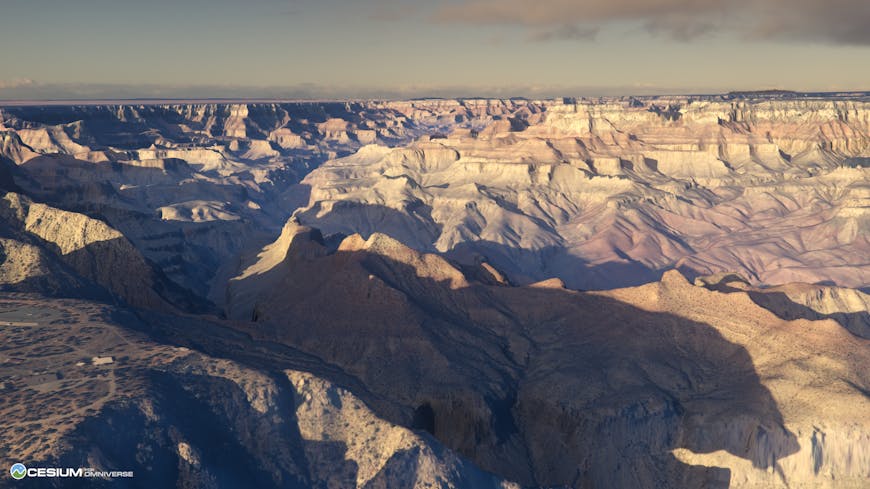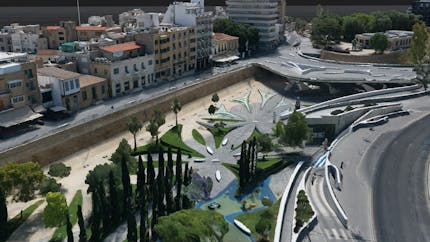Cesium Releases in April 2023
Cesium for Omniverse is now available. This extension for NVIDIA Omniverse enables developers to create industrial metaverse applications and simulations in precise geospatial context and stream real-world 3D content. We also announced the Cesium Ecosystem Grants program to promote innovation, interoperability, and collaboration—check out the FAQs and apply for funding!
CesiumJS 1.104 Release
CesiumJS 1.104 is now available. Starting with CesiumJS 1.104 the readyPromise pattern has been deprecated across the API. It will be removed in CesiumJS 1.107. This has been done to facilitate better asynchronous flow and error handling. (#11059)
Other highlights of the release include:
- Added asynchronous constructors for ImageryProviders, TerrainProviders, 3D Tilesets, and Models.
- Fixed various race conditions from asynchronous operations. #10909
- Fixed Cesium.Viewer instantiated inside lit components: CreditDisplay is missing its styles. #10907
For more details, see the changelog. You can subscribe to the Cesium release roundup thread on the community forum to get notifications about our monthly releases.
Cesium for Unreal 1.24.0 Release
Cesium for Unreal has been updated for Unreal Engine 4.27, 5.0, and 5.1.
This is the last Cesium for Unreal release that will support Unreal Engine v4.27. Future versions will require Unreal Engine v5.0+.
Some important changes in this release include:
- The
FlyToAltitudeProfileCurve,FlyToProgressCurve,FlyToMaximumAltitudeCurve,FlyToDuration, andFlyToGranularityDegreesproperties ofGlobeAwareDefaultPawn/DynamicPawnmay now be read and written from Blueprints. - Added
CreateNavCollisionproperty toCesium3DTileset. When enabled, the tileset may be used with Unreal’s Navigation System. - Added an option on
Cesium3DTilesetto ignore theKHR_materials_unlitextension entirely and use standard lighting and shadows. - Improved performance, particularly with “Forbid Holes” mode enabled on a tileset.
Check the Cesium for Unreal (UE4) release, the Cesium for Unreal (UE5) release, and the Cesium for Unreal Samples release for the full list of updates.
Cesium for Unity 1.0.0 Release
After several preview releases, this month we are releasing the official Cesium for Unity v1.0.0! While there is so much more we can and will do in future versions, we believe it has reached a level of stability and performance that makes it suitable for use in production applications, and the version number reflects that.

The globe, scaled down and embedded in Unity’s “3D Sample Scene (HDRP)” using the new CesiumTileExcluder.
Highlights of the release include:
- Added support for Unity's built-in render pipeline.
- Points clouds can now be rendered with attenuation based on geometric error, significantly improving their appearance.
- Added support for KTX2 and WebP images.
GameObjectinstances created for the tiles in aCesium3DTilesetnow inherit thelayerof the parent tileset.- Tileset and raster overlay credits are now shown in the Editor, not just at runtime. This makes it easier to comply with data provider requirements.
- Added new parameters to
CesiumRuntimeSettingsallowing control over the on-disk request cache. - Numerous bug fixes and performance improvements.
Check the changelog for the full list of updates, and follow our Cesium for Unity tutorials to get started.
Cesium for Omniverse 0.4.0 Release
After releasing Cesium for Omniverse in March, we have updated the extension. Highlights of this release include:
- Fixed a crash when removing the last available access token for a tileset.
- Added search field to the asset window.
- Added placeholder token name in the create field of the token window.
- No longer printing "Error adding tileset and imagery to stage" when adding a tileset.
- Better handling of long names in the asset details panel.
- Upgraded to cesium-native v0.22.1.
Peruse the changelog for the full list of updates, and get started with our Cesium for Omniverse tutorials.

The Grand Canyon in Cesium for Omniverse.

